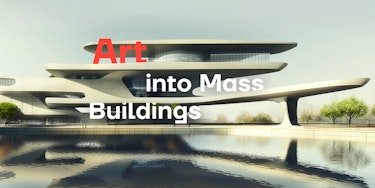The contemporary architectural landscape often grapples with the tension between mass production and artistic expression. As urbanization accelerates, the demand for cost-effective and efficient building solutions grows, frequently at the expense of creativity and uniqueness. This article explores the myriad ways in which art can be seamlessly woven into the fabric of mass-produced architecture, ultimately redefining the built environment.
Facade Treatments
Murals and Large-Scale Paintings
Murals and large-scale paintings offer a vibrant and expressive method to revitalize building facades. By commissioning local or renowned artists to create site-specific works, buildings can become iconic landmarks within their urban context. These murals can reflect local culture, history, or thematic elements related to the building’s purpose. For instance, a residential complex could feature murals depicting community life or natural elements, creating a warm and inviting atmosphere.
Textured Surfaces and Reliefs
Incorporating textured surfaces and reliefs into building facades adds depth and complexity. Techniques such as bas-relief, etching, and carving can create intricate patterns that play with light and shadow, offering a dynamic visual experience throughout the day. These textures can be designed to narrate stories or abstract concepts, contributing an additional layer of meaning to the building.
Innovative Cladding Materials
The use of innovative cladding materials like perforated metal panels, ceramic tiles, or composite materials allows architects to explore artistic designs while ensuring durability and functionality. Perforated metal panels, for example, can be customized with artistic patterns that transform facades into elaborate artworks, while ceramic tiles can offer vibrant colors and intricate designs.
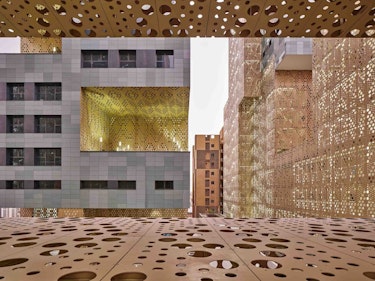
Credit: Archello
Interior Spaces
Custom-Designed Wall Installations
Wall installations can range from large-scale murals to three-dimensional artworks that become focal points within interior spaces. These installations can be tailored to complement the building's design language and purpose. For example, in a corporate office, abstract art installations can reflect the company’s values and culture, creating an inspiring environment for employees.
Sculptural Elements
Sculptural elements within interior spaces serve as both decorative and functional features. Freestanding sculptures or integrated sculptural forms in furniture and fixtures can create a sense of intrigue and sophistication. In public buildings like museums or libraries, sculptures can provide educational value, representing historical figures or abstract concepts related to the institution’s mission.
Artful Lighting Solutions
Lighting plays a crucial role in enhancing interior spaces. Artful lighting solutions, such as custom-designed chandeliers, LED installations, or strategically placed light fixtures, can create dramatic effects and highlight architectural features. For instance, a series of artistically designed pendant lights in a hotel lobby can set a luxurious and welcoming tone.
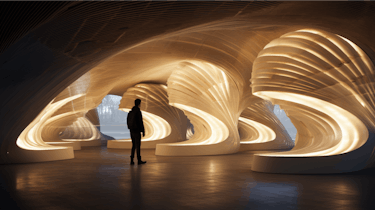
Credit: Parametric World
Public and Communal Areas
Bespoke Sculptures
Public and communal areas, such as parks, plazas, and courtyards, benefit greatly from the inclusion of bespoke sculptures. These sculptures can act as landmarks, meeting points, or simply as aesthetic enhancements to the space. They often reflect the local culture, environment, or historical context, making the area more relatable and engaging for the community.
Interactive Installations
Interactive installations invite public engagement and foster a sense of community. These can include kinetic sculptures that move with the wind, musical installations that produce sounds when touched, or digital displays that respond to movement. Such installations not only entertain but also encourage social interaction and create memorable experiences.
Art-Infused Landscaping
Incorporating art into landscaping design enhances the aesthetic and experiential quality of public spaces. This can include artistic benches, pathways, and water features that blend seamlessly with natural elements. For instance, a garden designed with artistic mosaics or sculptural fountains can provide a peaceful retreat and a visually stimulating environment.
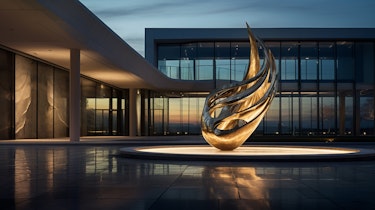
Credit: Bespoke Sculptures & Statue Manufacturers
Digital Art and Projections
Dynamic Light Shows
Building facades can be transformed into dynamic canvases through the use of light shows and projections. These can be programmed to change with seasons, special events, or real-time data, creating an ever-evolving visual experience. Light shows can highlight architectural details, create abstract patterns, or even tell stories, engaging passersby and adding vibrancy to the urban landscape.
Digital Murals
Digital murals offer a flexible and dynamic approach to integrating art into architecture. These can be displayed on large screens or projected onto building surfaces, allowing for easy updates and changes. Digital murals can feature animations, interactive elements, or rotating artworks from various artists, keeping the visual content fresh and engaging.
Interactive Displays
Interactive displays, such as touchscreens or motion-responsive installations, engage users directly. These displays can provide information, entertainment, or educational content, enhancing the user experience. For example, an interactive wall in a museum lobby can allow visitors to explore historical events or art pieces through touch-sensitive displays.
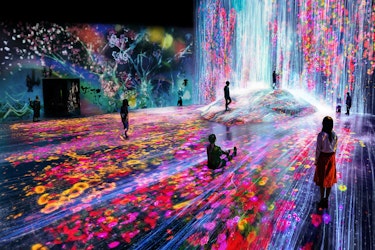
Credit: Smithsonian Magazine
Cultural and Historical Integration
Commemorative Installations
Integrating commemorative installations within mass-produced buildings can provide historical context and cultural significance. These installations, which might include plaques, statues, or artistic timelines, serve to honor notable events or figures associated with the location. This not only enriches the cultural landscape but also educates residents and visitors about the area's heritage.
Thematic Designs
Thematic designs in building elements can create a cohesive narrative throughout a development. By weaving cultural or historical themes into architectural details, such as door frames, windows, and columns, buildings can tell a story. For instance, a building in a historically significant area might incorporate motifs and design elements from a particular era, creating a sense of continuity and respect for the past.

Credit: Homedit
Collaborative Art Projects
Community Art Initiatives
Engaging the community in the artistic process can foster a sense of ownership and pride in a development. Community art initiatives might involve local artists and residents in creating murals, sculptures, or installations. These collaborative projects can reflect the community’s identity and values, making the building more meaningful and inclusive.
Artist Residencies
Establishing artist residencies within mass-produced developments can stimulate creativity and cultural exchange. By providing artists with space and resources to create on-site, buildings can benefit from a continuous infusion of new artistic ideas and works. This approach not only supports the arts but also keeps the environment dynamic and engaging.
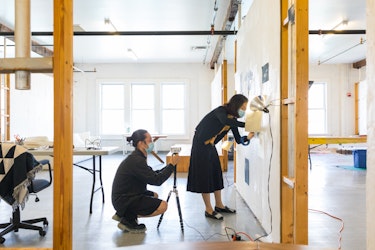
Credit: Lower Manhattan Cultural Council
The applications of art in mass-produced buildings are vast and varied, encompassing everything from facades and interiors to public spaces and digital displays. Each intervention is an opportunity to tell a story, evoke emotion, and create a sense of place. As architects, designers, and stakeholders, we have the power to transform the ordinary into the extraordinary, making our cities more vibrant, liveable, and inspiring.
